Volume 26 · Number 1 · Fall 2008
100 Ways
that UC Davis Has Transformed the World
Agriculture
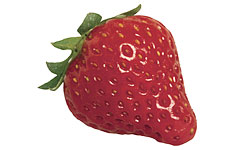
Strawberry fields.
Selective breeding by UC Davis scientists, dating back to the 1950s, led to bigger, brighter and more flavorful strawberry varieties. Thanks to research by the legendary team of Royce Bringhurst and Victor Voth, California strawberry yields skyrocketed from six to 25 tons per acre. Today, strawberries are consistently among the top 10 crops in the state and the biggest single source of patent revenue for UC Davis.
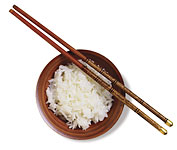
Rice for the world.
Today, more than half of the world’s 6 billion people depend on rice for food. At UC Davis, agricultural engineers and plant scientists have since the 1930s developed new harvesting and processing equipment; improved fertilizer and herbicide management; boosted grain quality; and helped farmers protect water, air and wildlife habitat. Genetics alumnus Gurdev Khush, Ph.D. ’60, went on to head the International Rice Research Institute in the Philippines and receive the 1996 World Food Prize for his work in developing new, hardier rice varieties. Following in his footsteps, campus researchers today are working to develop rice varieties that can better withstand drought, flooding and salty environments.

Dairy improvements.
Better sanitation procedures, improvements in raw milk handling and quality, and innovations that have reduced the environmental impact of livestock waste have contributed to making California the nation’s largest dairy state. The J-5 vaccine alone, developed in 1988 by veterinary medicine faculty to prevent mastitis in dairy cattle, saves producers $11 million every year.

Science of food.
For generations, UC Davis has brought the world new and improved foods, including fruit cocktail, fruit nectars and bottled prune juice that were developed by William Cruess, considered to be one of the fathers of modern food science and technology, and his colleagues. In 1925, department scientists were the first to discover how to freeze orange juice. UC Davis food scientists pioneered the study of how fatty substances called lipids oxidize in food and human tissue, raising the risk of cardiovascular disease, and how certain plant-based foods work as “antioxidants” to counteract that process. Researchers also developed magnetic resonance imaging techniques to detect food defects and improve food processing, as well as edible packaging films made from milk proteins to protect nuts from rancidity and fresh-cut fruits and vegetables from moisture loss and discoloration.
Saving farmland.
UC Davis scholars helped develop and revise California’s Williamson Act, landmark legislation that offers tax relief to farmers for keeping their land in agriculture. The act covers more than half of the state’s 29 million acres of farmland.
Living treasures.
UC Davis provides a reliable source of healthy and genetically diverse plants for the world. In 1958, a UC Davis program was created to maintain and distribute to commercial nurseries disease-free grapevines, tree fruits and nuts. That program, now known as Foundation Plant Services, has expanded to do the same for strawberries, sweet potatoes and roses. UC Davis is also home to a priceless tomato seed bank and the U.S. Department of Agriculture’s National Clonal Germplasm Repository, which archives rooted cuttings and budded rootstocks of a number of important plants.
Going buggy.
Since UC Davis’ earliest beginnings as the University Farm, campus insect experts have developed information and conducted research aimed at controlling exotic and invasive pests. One of the first efforts helped farmers cope with a whitefly infestation. Today, entomologists are working to better understand and manage pests like the Mediterranean fruit fly and the light brown apple moth. UC Davis is also home to the UC Statewide Integrated Pest Management Program, established in 1979 to provide practical science-based information on pest management to everyone from home gardeners to commercial growers.
Cornucopia of crops.
Dozens of new varieties of tree fruits, nuts, vegetables, melons, forages, grains and field crops have been developed at UC Davis. Traditional plant breeding methods improved taste, color, texture, nutritional quality, disease resistance and yield capacity in food and fiber crops. Researchers here were also the first to transfer a foreign gene into a walnut plant — the first such successful gene transfer in any fruit or nut crop. Similar techniques in molecular biology are paving the way for further crop improvement using both selective breeding and genetic engineering.

Clothing advances.
Flames and germs are no match for textiles and clothing from UC Davis, where scientists developed safer and more comfortable firefighting gear, and antibacterial garb for medical personnel, agricultural workers and soldiers.

Irrigation innovations.
Over the first half of the 20th century, UC Davis researchers shaped orchard and vineyard practices throughout California and set the stage for cultivation of arid lands worldwide. In recent decades, irrigation studies have led to reduced water use for flower and nursery operations, improved irrigation timing for grapes and subsurface drip irrigation for processing tomatoes.

Sustainable agriculture.
Many once-controversial ideas about sustainable farming are now mainstream thanks to decades of research and education by such UC Davis-based programs as Sustainable Agriculture Farming Systems and the UC Sustainable Agriculture Research and Education Program. They have studied fertilizer use, pest control, soil health and water conservation, and shared those findings with growers interested in agriculture that stewards resources wisely and avoids negative social impacts while keeping farms fiscally sound.
Ideas to products.
From strawberry varieties to pet vaccines to telecommunications technology, inventions born at UC Davis are being turned into products and services. Since 1975, 41 new companies have been spun off from the campus, and the university holds a portfolio of 875 active patents, plant varieties and other intellectual property. In fiscal year 2006–07, UC Davis earned just over $8 million in royalties and fees from licensing inventions.
Beef cattle.
UC Davis’ wide-ranging research expertise in the area of beef cattle has revolutionized that industry. In 1947, animal scientist Max Kleiber pioneered a new understanding of cattle nutrition and metabolism that led the way for a more efficient feeding process. During the 1960s, researchers followed up on Kleiber’s work by creating the California Net Energy System, which further developed optimal cattle feeding methods. In recent years, computer modeling has shown how environmental conditions can help or hinder cattle growth.
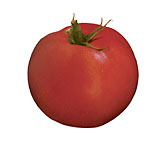
We say tomato.
UC Davis has touched every aspect of California’s tomato industry. Geneticist Charles Rick roamed the world for decades, collecting more than 2,600 wild tomato seeds in order to produce better tomato varieties. Today a UC Davis tomato seed bank, named in his honor, is the most diverse collection of tomato seeds in the world. During the 1960s, scientist Gordie “Jack” Hanna and agricultural engineer Coby Lorenzen saved California’s processing tomato industry. The pair developed what would become known as the UC-Blackwelder tomato harvester and a more cube-shaped processing tomato, sturdy enough to withstand mechanized harvesting.
Plant life.
For decades, noted plant biologists at UC Davis have made contributions to our understanding of how plants evolve, grow, fight infections and pests, respond to light, absorb nutrients from the soil and turn sunlight into sugars. Their discoveries have opened new avenues for developing crops that could grow in cold, dark climates or salty soils, as well as reducing pesticide use, increasing crop yields and producing new sources of food oils and fuel. Moreover, these researchers have written classic textbooks, including one series with an 80-year publication span, that have helped train generations of new plant scientists around the world.
Sensory science.
With the classic textbook Principles of Sensory Evaluation of Foods (1965), UC Davis faculty gave companies worldwide the scientific tools that enable more informed decisions in product development and quality control. Today UC Davis boasts more faculty associated with sensory science than any other U.S. university. Their contributions include the Wine Aroma Wheel, which lays out a common language for wine evaluation, and research linking some taste sensations — like those from sparkling wine or chili peppers — to pain.

Olive center.
Plant and food scientists associated with the new UC Davis Olive Center are poised to do for olives and olive oil what the university did for grapes and wine. In investigating better methods of olive growing and processing, the scientists have plenty to work with: more than 2,000 olive trees in the campus landscape and research orchards (thought to be the most extensive collection in North America) and an up-and-coming olive oil business, with brand names like The Silo and Gunrock.
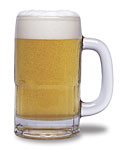
Roll out the barrel.
Founded in 1958, UC Davis’ brewing program is the only accredited four-year brewing program offered by a major U.S. university. Recent research in the program has examined beer quality, including the stability of beer flavor and foam, and the potential nutritional benefits of beer.

Bluetongue eradication.
Bluetongue virus, a disease that has had a significant negative economic effect on the livestock industry, has been eradicated in parts of the United States, thanks to faculty research carried out at UC Davis for more than 30 years. Faculty members first characterized the disease in sheep, developed the first bluetongue diagnostic test and vaccine in the early 1960s, and led the way to finding safer, more effective vaccines.

Wines and vines.
A UC grape-growing and winemaking program that stretches back to 1880 has transformed the industry. At the repeal of Prohibition, California vintners were primarily making jug wine, fermentation science was in its infancy and growers struggled with the vine-destroying Phylloxera root louse. Today California is one of the world’s premier wine regions, thanks to numerous UC Davis contributions. Early research identified the grape varieties best suited to California growing conditions and developed the technology for making consistently sound wines. Researchers have used DNA fingerprinting to trace the origin of the world’s leading wine grapes, developed wine grape vines and rootstocks that are resistant to vineyard pests and diseases and identified potential health benefits of wine. A modern teaching and research winery will soon be constructed as part of the Robert Mondavi Institute for Wine and Food Science, which will be surrounded by a teaching and research vineyard.
Safeguarding your food.
Since the early 1900s, UC Davis and the field of food safety have grown up together. Today campus researchers from a variety of disciplines are conducting research, training students and informing the public about myriad food-safety challenges. UC Davis veterinarians help the California dairy industry prevent and detect microbial, anti-biotic and chemical contamination. Food, plant and veterinary researchers also have teamed up to better understand how a harmful strain of E. coli bacteria infected fresh spinach in 2007 and to prevent similar future contaminations. UC Davis researchers are also working with government and industry leaders to safeguard the state’s and nation’s food supplies against accidental or intentional contamination.
Cattle protection.
Cattle in Africa are being protected from rinderpest — a measles-like plague that has caused famine and economic devastation — thanks to a genetically engineered vaccine developed at UC Davis. Researchers at the International Laboratory of Molecular Biology for Tropical Diseases also produced an inexpensive diagnostic kit simple enough to be used in the field.
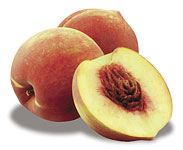
Feeding the world.
UC Davis scientists have helped increase agricultural production in countries around the globe, particularly working to improve the quality of life of people in developing countries. Areas of collaboration include agriculture, malnutrition, maternal nutrition, animal husbandry and food production. From the lab to the marketplace, UC Davis scientists have shared their ideas and knowledge with farmers, scientists and policymakers in countries like Afghanistan, Egypt, Chile, Australia and Ghana. Soon after Sept. 11, university faculty members traveled to Afghanistan as part of an international effort to revitalize that country’s agriculture system after two decades of war. And Chile is one of the world’s leading fresh-fruit exporters, thanks to a 1960s educational partnership with UC Davis that was recently renewed after a visit to campus by Chilean President Michelle Bachelet in June.
Climate change.
For decades, UC Davis has been anticipating climate change and its impacts on agriculture, native plants and animals, and human health. Researchers here pioneered the now-ubiquitous use of stable isotopes in understanding global carbon and nitrogen cycles.

Coming up daisies.
Today California is the nation’s largest producer of gerbera flowers, one of the most popular ornamental flowers in the world, with more than 200 varieties. When air-transport increased competition from South America and other factors threatened the California cut-flower producers, UC Davis horticulturists worked closely with growers to save the industry by developing new crops like gerberas and potted plants, energy-efficient greenhouses and postharvest handling systems. Today, California floriculture is a $1 billion industry.
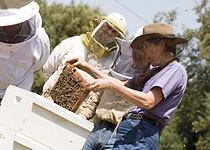
Honeybee research.
During his career as a UC Davis entomologist from 1947 to 1974, Harry Laidlaw perfected bee artificial insemination — allowing selective breeding of honeybees and the fundamental study of bee genetics. Today, in the university’s Laidlaw lab, a new generation of entomologists is doing critical research into colony collapse disorder, which is crippling the nation’s stock of pollinators.
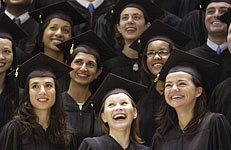
A world of alumni.
From the time the first students graduated in 1911, UC Davis alumni have been making their mark in the world — and beyond. Among their countless achievements are winning Olympic gold medals, directing Oscar-winning Disney films, heading UNICEF and flying through space as astronauts. With every year, the Aggie impact multiplies. From nine students in the 1911 class, our living alumni total has grown to 185,000.
« Return to 100 ways introduction

